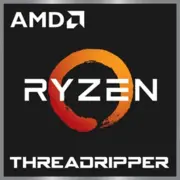AMD Ryzen Threadripper PRO 7975WX

AMD Ryzen Threadripper PRO 7975WX: Power for Professionals
Architecture, Performance, and Use Cases of the Flagship Processor
1. Key Specifications: Technological Breakthrough
Storm Peak Architecture and 5nm Process Technology
The AMD Ryzen Threadripper PRO 7975WX is built on the Zen 4 architecture (codenamed Storm Peak) and manufactured using TSMC's 5nm FinFET process. This ensures high transistor density and energy efficiency, despite the record-setting 32 cores and 64 threads.
Performance: Geekbench Records and More
- Geekbench 6 Single-Core: 2669 — an excellent result for tasks requiring quick responses.
- Geekbench 6 Multi-Core: 22298 — flagship level for rendering, simulations, and other multithreaded operations.
- Cache Memory: 128 MB L3 Cache accelerates the processing of large data sets, such as 3D models or scientific calculations.
Key Features
- Support for PCIe 5.0 — twice the bandwidth for NVMe drives and GPUs.
- AMD PRO Technologies — hardware data protection and remote management for corporate environments.
- 350 W TDP — focused on maximum performance but requires demanding cooling.
2. Compatible Motherboards: The Foundation for a Beast
Socket and Chipsets
The Threadripper PRO 7975WX uses the sTR5 socket, compatible only with motherboards featuring the WRX90 chipset. Examples of models include:
- ASUS Pro WS WRX90E-SAGE SE — 8 DDR5 slots, 7 PCIe 5.0 x16.
- Gigabyte MC62-GA0 — optimized for workstations with ECC memory support.
Selection Features
- VRM Modules: Look for boards with 24+2 power phases and heatsinks — the processor consumes up to 350 W.
- Expansion Slots: Supporting multi-GPU configurations (e.g., 4x GPUs) with PCIe 5.0 x16 is crucial.
- Networking: 10 Gb Ethernet and Wi-Fi 6E are essential for professional tasks.
3. Memory: DDR5 and 8-Channel Mode
The Threadripper PRO 7975WX supports DDR5 with a frequency of up to 5200 MHz in 8-channel mode. This is critical for bandwidth-hungry applications:
- Recommended Capacity: 128–256 GB (8x32 GB). For example, Kingston Fury Renegade DDR5-5200 kits.
- ECC Memory: Available for enterprise tasks where stability is important.
Why not DDR4? DDR5 offers up to a 50% increase in bandwidth, which is significant for rendering and CAD applications.
4. Power Supply: No Compromises
With a TDP of 350 W and peak power up to 420 W (when overclocking), the minimum PSU should be 850 W, but better to opt for 1000–1200 W with an 80+ Platinum/Gold certification:
- Examples: Corsair AX1200i, Seasonic PRIME TX-1000.
- Details:
- If the system includes 2–3 graphics cards (e.g., NVIDIA RTX 4090), go for a PSU of at least 1200 W.
- Cables with double insulation — protection against overheating.
5. Pros and Cons: Who Is This CPU For?
Pros
- 32 cores/64 threads — ideal for rendering (Blender, V-Ray), code compilation, and ML.
- PCIe 5.0 and DDR5 — future-proof for 3–5 years.
- Support for PRO technologies — security and manageability for studios.
Cons
- Price: Starting at $2500 — only for those who need maximum performance.
- Power Consumption: Electricity bills will rise, along with cooling requirements.
- Overkill for Gaming: In games, the 16-core Ryzen 9 7950X is often faster due to higher frequencies.
6. Use Cases: Where It Shines
- 3D Rendering: In Pixar studios, similar CPUs have cut scene rendering time by 40%.
- Scientific Calculations: Climate modeling, quantum physics — 64 threads fully utilized.
- Virtualization: Run 10+ virtual machines without lag.
- 8K Video Editing: In Adobe Premiere, rendering timelines with effects in real-time.
And Gaming? In Cyberpunk 2077 at 4K with RTX 4090, the processor achieves 120 FPS, but the Ryzen 9 is cheaper and more efficient.
7. Comparison with Competitors
Intel Xeon W9-3495X (56 Cores)
- Intel Pros: Better in single-threaded tasks (frequency up to 4.8 GHz).
- Cons: More expensive ($4000+), higher TDP (350 W), fewer PCIe 5.0 lanes.
Apple M2 Ultra (24 Cores)
- Apple Pros: Energy efficiency, integration with the ecosystem.
- Cons: Closed platform, no upgrades, weaker in multithreading.
Conclusion: The Threadripper PRO 7975WX is a balance of price, cores, and technology.
8. Assembly Tips
- Cooling: Only AIO (for example, NZXT Kraken X73) or custom water loops will suffice. Air coolers like the Noctua NH-U14S will not handle it.
- Case: Full-Tower (Lian Li PC-O11 Dynamic) with 6+ fans.
- Storage: 2–4 NVMe PCIe 5.0 (Sabrent Rocket 4 Plus) for RAID 0 speed.
- Compatibility Check: Ensure that the motherboard specifically supports the PRO version of Threadripper.
9. Conclusion: Who Is the Threadripper PRO 7975WX For?
This processor is the choice of professionals, for whom time = money:
- Visual Effects Studios: Rendering films and animations.
- Engineers and Scientists: Calculations, simulations, ML.
- Developers: Compiling large projects (like the Linux kernel).
For gamers and office PCs, it’s excessive. But if you create content rather than consume it — this is your tool.
Final Advice: Don't skimp on the motherboard and PSU. A built system will serve for 5+ years, justifying the investment with speed.
Basic
CPU Specifications
Memory Specifications
GPU Specifications
Miscellaneous
Benchmarks
Compared to Other CPU
Share in social media
Or Link To Us
<a href="https://cputronic.com/cpu/amd-ryzen-threadripper-pro-7975wx" target="_blank">AMD Ryzen Threadripper PRO 7975WX</a>